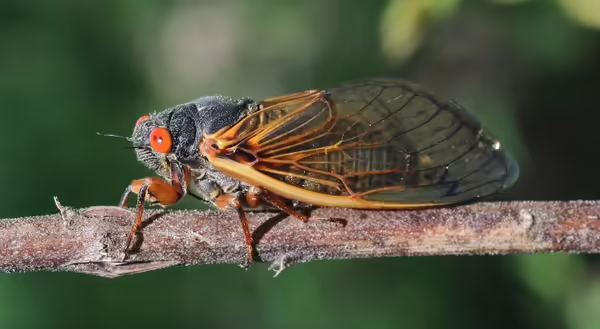
Early 2024 features some excellent, once-in-a-lifetime natural events. If you missed the solar eclipse in April, get ready for a rare ecological event about to unfold in the coming weeks. Whether we want to experience it or not, we’ll be immersed in a mass emergence of periodical cicadas across the state of Illinois.
Periodical cicadas are the longest-living insects on earth, spending either 13 or 17 years underground before emerging to mate and complete their lifecycle. Amazingly, they only occur in eastern North America. This year is especially significant because Illinois will experience the overlapping emergence of both 13 and 17-year cicada broods.
Overlapping Cicada Broods
In central Illinois, we will experience the emergence of Brood XIX, also known as the Great Southern Brood, which appears every 13 years. It spans parts of Illinois, Iowa and Missouri, extending all the way south into Georgia and other southern states.
Northern Illinois will see Brood XIII, the Northern Illinois Brood, which is on a 17-year cycle. While neither of these broods overlap in their distribution, the co-emergence this year is an extremely rare occurrence. The last time this happened was in 1803 and the next time it will line up will not be until 2245.
When these insects emerge, they bring a massive amount of energy to the terrestrial landscape. This energy is spread around, either as cicadas are consumed by predators, or they die and decompose back into the soil. Research has noted boosted growth and reproduction in forest plants following the cicada years. Everything from soil microbial populations to aquatic life has been shown to benefit from decomposing cicadas.
How Cicadas Shape the Environment
With every ecological marvel such as this, there are winners and losers. Most gardeners are concerned about which plants in their space may wind up being on the losing end. When contemplating the impact on your garden space, it helps to understand the cicada lifecycle.
After quietly feeding underground on roots for many years, periodic cicadas emerge from the soil as nymphs and quickly develop into adults. While the adults do feed on plants, their feeding rarely translates into any damage.
The real damage to plants occurs on woody plants after the adults mate, as females lay their eggs in twigs ½” in diameter and smaller. The act of egg-laying leaves a narrow slit which can kill branch tips. On large mature plants, this damage will have no ill effects, but on younger plants, the cumulative twig death can be significant.
Cicadas have been noted to use over 75 species of woody plants for egg-laying and they don’t appear to have consistent preferences based on research. If you have newly planted or smaller trees or shrubs that may be sensitive, you may want to protect them with netting. Be sure that the netting has spaces less than ¼” and allows plenty of light through. Affix it firmly to the base of the tree, covering the canopy and sealing out any cicadas that may crawl up the trunk.
In our area, cicada nymphs are emerging now and we should start to hear loud singing from adult males in a matter of days. Female egg-laying typically occurs about 7-10 days after the first sign of males and continues for about 30 days.
Tree Planting and Cicada Considerations
I recommend a “wait and see” strategy with tree or shrub protective measures. While protective covering saves your plants from cicada damage, it may cause some unintended damage by blocking sunlight or limiting airflow. I think it’s wise to wait for signs of cicadas before installing anything unnatural around woody plants.
Depending on your location, you may not have that many cicadas. Keep in mind that cicadas are forest-dwelling insects and will emerge in large numbers around areas with significant forest cover, so their distribution in central Illinois will be fairly spotty. They are not known to travel far (around ¼ mile), and if you aren’t located close to areas with historical tree cover, you may not have a lot of cicadas on your property.
In addition, urbanization is detrimental to these insects. During their time under the soil, they persist at relatively shallow depths, around 8” deep. In areas where significant urban development has occurred, the soil alternation necessary to build homes, roads, sidewalks and other features may have wiped out historic cicada populations.
To err on the side of safety, I recommend delaying any new tree planting until after the cicadas have completed their lifecycle, especially if you live near forested areas. However, tree planting in late summer as cicadas wind down is problematic given the hot, dry conditions. So, the best recommendation may be to wait for fall this year.
As we are inundated with these amazing insects over the summer, keep in mind the ecological significance of this event and take some time to admire the show. It's truly a once-in-a-lifetime convergence of cicada broods and represents a long ecological history unique to North America.
Photo Caption: Periodic cicadas are emerging around central Illinois now, representing a once-in-a-lifetime ecological event across the state of Illinois this summer. Photo by Chris Evans.